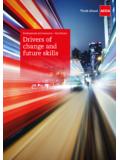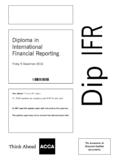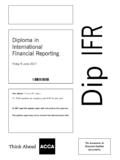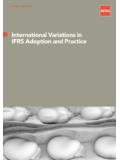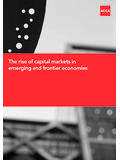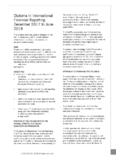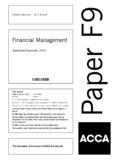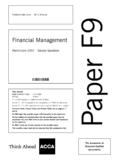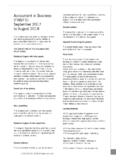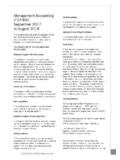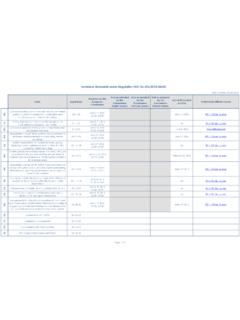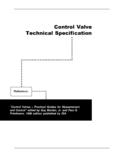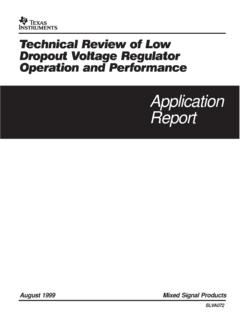Transcription of The rise of peer- to-peer lending in China - ACCA Global
1 The rise of peer - to- peer lending in China : An overview and survey case study About ACCA. ACCA (the Association of Chartered Certified Accountants) is the Global body for professional China 's peer -to- peer accountants. It offers business-relevant, first-choice qualifications to people of application, ability and lending sector has ambition around the world who seek a rewarding career in accountancy, finance and management. emerged as the largest and most dynamic ACCA supports its 178,000 members and 455,000. students in 181 countries, helping them to develop online alternative successful careers in accounting and business, with the finance sector in the skills required by employers. ACCA works through a network of 92 offices and centres and more than world. This report 7,110 Approved Employers worldwide, who provide high standards of employee learning and explores the emergence, development. Through its public interest remit, ACCA characteristics and promotes appropriate regulation of accounting and conducts relevant research to ensure accountancy evolving policy continues to grow in reputation and influence.
2 Environment of peer -to- Founded in 1904, ACCA has consistently held unique peer lending in China core values: opportunity, diversity, innovation, integrity and accountability. It believes that accountants bring and presents detailed value to economies in all stages of development and seek to develop capacity in the profession and findings from a survey encourage the adoption of Global standards. ACCA's of borrowers and core values are aligned to the needs of employers in all sectors and it ensures that through its range of lenders using China 's qualifications, it prepares accountants for business. first online direct ACCA seeks to open up the profession to people of all backgrounds and remove artificial barriers, peer -to- peer lending innovating its qualifications and delivery to meet the diverse needs of trainee professionals and their provider, Paipaidai. employers. More information is available at: The Association of Chartered Certified Accountants October 2015.
3 Contents About the 4. 1. Executive 5. 2. The growth of peer -to- peer lending in 7. 3. Financial innovation and peer -to- peer lending in 9. 4. A typology of China 's peer -to- peer lending 11. 5. Survey findings from Paipaidai borrowers and 15. 6. China 's peer -to- peer lending regulatory 20. 7. 21. Appendix 1: SME classifications in 22. 23. About the authors 4. LUKE DEER ACKNOWLEDGEMENTS. Luke Deer is a post-doctoral research associate The research team would like to thank the industry participants in with the Department of Political Economy at the China who spoke with the research team about the sector and their University of Sydney and a research associate provider details. Special thanks are due to Bai Dengyu at the China with the University of Cambridge Centre for Association of Microfinance (CAM) for sharing his views and arranging Alternative Finance and the Cambridge Judge introductions with industry participants, as well as Zhang Jun and Hu Business School.
4 Luke's research interests are Honghui at Paipaidai, Barry Freeman at Jimubox, Pan Jing at in understanding the emergence and dynamics Dianrong, Tang Nan at RenRenDai and Chen Huan at CreditEase. of alternative finance in China . The research team would particularly like to thank Charlotte Chung JACKSON MI for her support in getting this report under way, Emmanouil Schizas for his feedback on the research proposal and survey design and Jackson Mi is an assistant professor in Walter Wu for arranging interviews in Beijing. finance at the Shanghai Maritime University and a postdoctoral research fellow at Fudan University in Shanghai. Jackson's doctoral research was on informal finance in China and his research interests include micro-finance, peer -to- peer finance and network finance. YU YUXIN. Yu Yuxin is a lecturer in the School of Economics and Finance at Shanghai International Studies University. Yuxin's research interests are in China 's financial markets and macro-economy, and in applications of big data, especially to peer -to- peer finance.
5 He has been a visiting scholar at Virginia Tech (Virginia Polytechnic Institute and State University) in the US. 1. Executive summary 5. China 's peer -to- peer lending market has tend to use more conventional credit China 's peer -to- peer become the largest in the world. The rapid allocation processes. At the same time, growth of online peer -to- peer lending in because of the relative lack of available credit lending market has China has been driven by the supply of funds information, most direct peer -to- peer lending become the largest in from retail investors and by the demand for platforms in China also tend to rely much the world. access to finance from individuals and from more on offline processes. the owners of small and micro businesses. By applying innovations in alternative finance, SURVEY FINDINGS. peer -to- peer lending in China is creating new channels of credit information and increasing This report also presents findings from the access to finance.
6 Over half the borrowers ACCA's own detailed survey of 935 borrowers from peer -to- peer lending providers who and lenders from China 's first online direct were surveyed for this report said they had no peer -to- peer lending company, Paipaidai. previous history of borrowing from traditional Paipaidai started offering unsecured online financial institutions, credit societies or other peer -to- peer micro-loans in 2007, initially to entities. Half the borrowers surveyed also said small e-commerce TaoBao' shops. By 2015, that their main reason for borrowing was to Paipaidai claimed over 1,200,000 active accumulate credit worthiness'. China 's members, borrowers and lenders. government has supported the continued According to Paipaidai's founders, in the growth of internet finance', including year to mid-2015, 42% of its borrowers peer -to- peer lending and equity were business borrowers and 58% were crowdfunding, while introducing moderately personal borrowers.
7 Loose regulatory policies' (PBOC 2015a). INDIVIDUAL BORROWER SURVEY. SIZE AND COMPOSITION OF lending RESPONSES. While as yet there is no verifiable data on the The demand for easier access to credit has volume of peer -to- peer lending in China , by been a key reason for the rapid growth of the end of 2015 it could be as high as peer -to- peer lending in China . According to US$20bn Retail investors are the the survey findings, for example, of those primary funding source for peer -to- peer respondents borrowing through Paipaidai: lending in China . The present research suggests that business borrowers, who are 87% selected the low borrowing mostly owners of small or micro businesses, threshold and easy borrower audit and some owners of medium-sized process as their main reason for enterprises, could make up between 20% borrowing through a peer -to- peer lending and 40% of peer -to- peer lending borrowers provider such as Paipaidai in China . This indicates a much higher share of peer -to- peer business lending in China 56% said that they had no previous than is the case in developed markets, which borrowing history from other financial have been dominated by peer -to- peer institutions such as a traditional banks or consumer credit societies 51% said that their main reason for CREDIT ENVIRONMENT AND DIVERSE.
8 Borrowing funds from a peer -to- peer PROVIDER MODELS. lending provider such as Paipaidai was to China 's credit and banking environment is accumulate credit worthiness'. also quite different to that in developed countries and this has contributed to a wider This last finding, about borrower motives, set of peer -to- peer lending provider models suggests that borrowers' demand for more in China than in other countries. One reason favourable access to credit mitigates some of is the diverse origins of peer -to- peer lending the risk of default from unsecured lending . providers in China . Although there are Online peer -to- peer lending creates new perhaps a minority of dedicated online forms of information transparency and with it technology providers, a large number of incentives for borrowers to meet their hybrid wealth-management companies and repayments in order to secure a positive informal banks have entered the sector. These online credit history. 1 According to data published by WangDaiZhiJia ( ), an online news site covering the peer -to- peer sector, the total transaction size of peer -to- peer lending in China at the end of 2014 was almost RMB253bn (about US$40bn).
9 Authors' calculations based on data from 2 See Wardrop et al. (2015: 17) for data on peer -to- peer business lending in the UK and Europe. The rise of peer -to- peer lending in China : 1. Executive summary 6. An overview and survey case study 57%. INDIVIDUAL INVESTOR RESPONSES requirement for peer -to- peer lending providers is that they must now hold borrower The supply of funds from individual retail and lender funds in custodian accounts with investors is a key reason for the growth of registered financial institutions'. This change peer -to- peer lending in China . By lending raises the hurdles for providers and it is likely through peer -to- peer providers, investors to lead to some consolidation, while securing have been able to get returns three to five the future growth of peer -to- peer lending . times higher than the bank deposit rate. Most of individual lender respondents individual lender respondents to the survey to the survey said they usually bid (57%) said they usually bid for loans with REPORT METHODS.
10 For loans with interest rates in the interest rates in the 12% to 18% range. This report explores the rise of peer -to- peer 12% to 18% range. lending in China to give SME communities The most common decision factors given by and organisations around the world a better lender respondents when making their bids understanding of peer -to- peer lending and on the Paipaidai platform were: other forms of alternative finance as a viable option for their financing needs. This report the borrower's credit rating (72%) takes a qualitative approach to analysis and is Paipaidai's loan security guarantee (72%) based on ACCA's primary research and the interest rate level of the loan (52%) secondary Chinese language sources. the borrower's certification status (51%). The primary data comes from the research Most lender respondents to the survey also team interviews with industry participants in said they were carrying out investments on China and from the primary research survey their own behalf (85%), with the remainder mentioned above.
